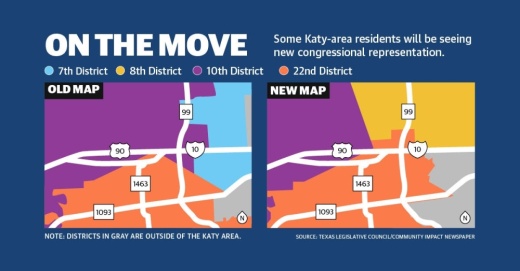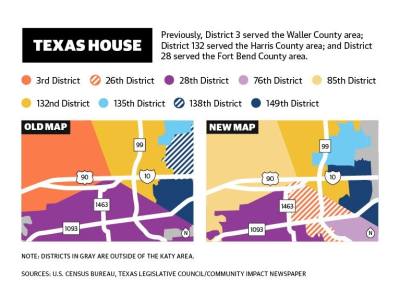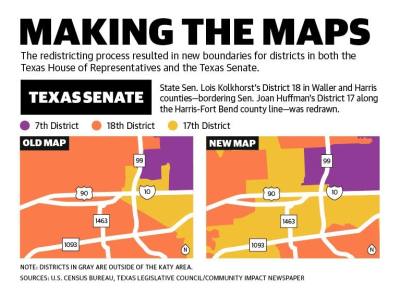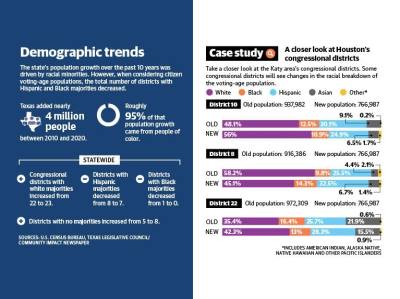After the U.S. Census Bureau’s 2020 data found population growth throughout the state, legislators approved new maps, which will go into effect in 2022.
State House Rep. Jacey Jetton’s House District 26, which serves Fort Bend County residents in the Sugar Land and Richmond areas, will be moving to the Cinco Ranch, Katy, Richmond and Rosenberg area.
Jetton, who announced his bid for re-election Nov. 9, said he is committed to Katy if re-elected in 2022 when the new districts take effect.••“Having Katy now is something I’m excited about,” Jetton said in an interview. “There’s a lot of younger families in Katy that have a lot of interest in making Texas great for their lives now—[and for their kids].”
Additionally, both Harris and Fort Bend counties redrew their county commissioner precinct lines, which will bring changes in representation. Fort Bend County officials made changes to all four precincts, and Harris County transposed two of its precincts, so most Katy residents who were represented by Precinct 3 will now be led by Precinct 4 Commissioner Jack Cagle as of Oct. 28, when the maps took effect.
Cagle said that no matter where the boundaries lay, he and Precinct 3 Commissioner Tom Ramsey will serve their respective constituents.••“I will be willing to stand wherever [Precinct] 4 is to make sure that I serve you, the constituents, and to make sure that no one ends up lacking service,” Cagle said in a video statement.
Population growth
Some advocates said the new maps fail to reflect growth through the state in communities of color.
Most of Texas’ population growth between 2010 and 2020 was driven within Asian, Hispanic and Black communities, according to census data, bringing Texas two new congressional districts for a total of 38 districts.
However, the number of Texas congressional districts with white majorities increased from 22 to 23 under the new maps, and the number of districts with Hispanic and Black majorities both fell by one to seven and zero, respectively, and the number of districts with no racial majority grew by three, according to the Texas Legislative Council.
Although the trends do not prove discrimination, Michael Li, a redistricting expert with the nonprofit law and policy institute Brennan Center for Justice, said the trends raise questions about Voting Rights Act violations.
“The real question is: Are there more opportunities for the minority communities that provided most of the state’s growth?” Li said. “There doesn’t seem to be, and that raises a lot of red flags about potential discrimination.”
Richard Murray, a political science professor at the University of Houston and former redistricting adviser to the Texas Legislative Black Caucus, said the process allows for redistricting committees to “crack” or “pack” populations, giving parties more control.
“We’re the only state that gained two seats in the country,” Murray said. “There’s immense pressure [on Republican lawmakers] to do something.”
Countywide look
In late October and early November, respectively, commissioners in Harris and Fort Bend counties voted to redraw their county precincts.
Harris County officials approved a new map for the county’s four precincts at an Oct. 28 meeting with a 3-2 vote with Cagle and Ramsey dissenting. The new map went into effect after the meeting, but officials said commissioners will have until March 31 to transition to the new precincts.
“[This map] stands in stark contrast to the radical gerrymandering passed in Austin, which was designed solely to preserve the power of the governor and Republican legislators at the expense of fair representation for all Texans,” Ellis said Oct. 28.
Under the new Harris County map, Spring and parts of Tomball and The Woodlands that were considered Precinct 4 are now in Precinct 3. Katy and areas west of Hwy. 290 now fall in Precinct 4. The new Precinct 3 also includes Crosby and Barrett, which were represented by Precinct 2.
Ramsey said he was disappointed by the new maps in an email.
“I’m disappointed that the court majority chose a map that results in unnecessary chaos,” Ramsey said.
Fort Bend County officials began their redistricting process in September. On Nov. 5, officials approved new maps, which will be enacted in 2022.
Precinct 1, led by Commissioner Vincent Morales, serves the largest portion of the county, extending from south of the Katy area to the southernmost part of the county. In the new maps, Precinct 1 will serve the Katy area.
Precinct 2, led by Commissioner Grady Prestage, will cover more of the county, going from serving urban areas in the northeast portion of the county to extending along Fort Bend County’s eastern-most boundary.
Precinct 3, which serves the Katy area, will move to the Sugar Land and Missouri City areas. Precinct 4, which serves Sugar Land and Missouri City, will cover Rosenberg and Richmond.
Texas House and Senate changes
Almost all Katy-area residents will see changes to their statewide districts when new maps are enacted in 2022. Texas House changes will affect Katy-area residents in Fort Bend and Waller counties. Changes to Texas Senate maps will affect a portion of Katy-area residents in all three area counties.
Texas Senate changes in the Katy area center on the redrawing of state Sen. Lois Kolkhorst’s District 18. Under the new maps, District 17 expands into all three area counties, and is surrounded by District 18 on three sides.
Marvin Marcell, governmental affairs consultant for the Fort Bend Economic Development Council, said there has been a massive change in the county’s Texas Senate district representing Fort Bend County at an Oct. 21 FBEDC meeting.
“Part of that is because there has been a major shift in population from rural into metropolitan areas,” he said.
Changes to Texas House districts will alter district boundaries for some Harris County residents and all Fort Bend County residents. Currently, state Rep. Cecil Bell serves District 3 in the Waller County area of Katy; state Rep. Mike Schofield serves the Harris County area in District 132; and state Rep. Gary Gates serves District 28 in the Fort Bend County area.
Under the new maps, District 132 will serve the Katy area in Harris County, and District 28 will split the Fort Bend County area with Districts 26 and 76.
“[The new districts] were drawn fairly,” said Jetton, who served on the redistricting committee. “We focused on the population growth. ... We have pocket communities of interest, [and] that’s how the maps got split up to make sure that we were keeping those communities of interest together.”
Moreover, Fort Bend County will gain a new district for the county entirely—House District 76, which was located in El Paso County in the old maps.
Congressional maps
In terms of U.S. congressional districts, Katy-area residents in Fort Bend County are served by U.S. Rep. Troy Nehls in the 22nd District, while U.S. Rep. Michael McCaul serves the 10th District, which extends east of Waller County into Harris County.
In the new maps, the 10th District will serve Katy’s Waller County area with the 8th District—led by U.S. Rep. Kevin Brady—serving most of Katy’s Harris County area. District 22 will still serve the Fort Bend County area and a small portion of Harris County.
Additionally, about 200,000 people were removed from the 7th Congressional District, led by U.S. Rep. Lizzie Fletcher, from parts of western Harris County, while 200,000 were added from areas around Sugar Land and Richmond, Marcell said.
When Black and Asian voters from Fort Bend County were redistricted into the 7th Congressional District, that also affected the adjacent 22nd District, Li said. The 22nd District, held by Nehls, shifted from 64% nonwhite under the old maps to 57% nonwhite under the new maps, according to the Texas Legislative Council.
Fort Bend County Judge KP George voiced opposition to the new maps in an Oct. 11 statement.
“[Splitting] Fort Bend County into three different congressional districts dilutes our majority share within our congressional district,” he said.
In an interview Oct. 27, George accused Republican lawmakers of gerrymandering in the new maps.
“It is horrible. It is literally diluting,” George said. “We got this congressional seat because of our population growth. Why do we do a census every decade and redistrict? We are doing it to reflect the population growth, and so that [means] Republicans [used] gerrymandering to solidify their power for the next decade.”
Several lawsuits have already been filed against the new maps, including a lawsuit by the Mexican American Legal Defense Fund arguing the maps are intentionally discriminatory.
Huffman, who served as the chair of the Senate’s Redistricting Committee, defended the maps and said they comply with the Voting Rights Act.
“We drew these maps race blind,” Huffman said at a September public hearing on the maps. “We have not looked at any racial data as we drew these maps.”
Shawn Arrajj, Emily Lincke and Jishnu Nair contributed to this report.








